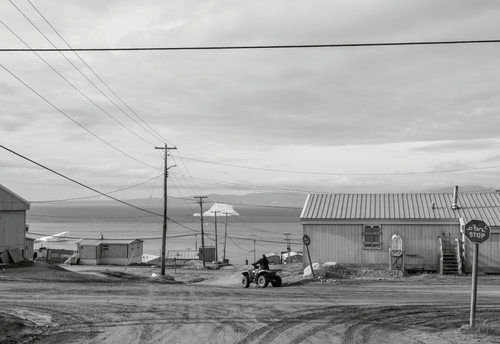

DEFINITION
Kaylee Baxter
There is a common perception of the Arctic as a desolate, frozen, and unchanging place. However, this is not the case: the Arctic is a culturally rich and dynamic environment, and one that is not frozen in either time or temperature. It is a living landscape.
Archaeologically, we can trace how past climate episodes and periods have impacted the Paleo-Inuit and ancestral Inuit cultures in the eastern Canadian and Greenland Arctic. Effectively, based on the distribution of archaeological sites during different cultural and climatic periods (i.e., where people were living), development of different tool types, changes to
how houses were designed and built, and what food sources were being hunted and harvested (i.e., how people were living), archaeologists try to determine how various cultures adapted over a 4500 year period in the eastern Canadian Arctic and Greenland. The physical evidence and materials that these different Paleo-Inuit and ancestral Inuit cultures have left behind or the “archaeological record” as we call it, are remnants of life, culture, and adaptation in the Arctic. Through these remnants, we can piece together the story of how life has continually changed throughout the “living landscape” of the Arctic prehistory.
The relationship between climate change and archaeology is not only apparent when investigating the past; modern climate change is actively destroying the archaeological record at present. Archaeological sites in the Arctic are quickly disappearing and degrading, mainly due to processes of coastal erosion and permafrost thaw. The Arctic, evidently, is not desolate, frozen, or unchanging. It is a living landscape that is highly dynamic and undergoing rapid changes.

Mittimatalik (Pond Inlet). Nunavut, Canada, 2024
Photography By Pamela EA
RESEARCH
Text by Sorah Park
Research by Delphi Drake Mudede
Fact-checking by Hailey Basiouny
November 7, 2024
• The Arctic is a landscape with rich ecological diversity, containing several cities with more than 30,000 people, vast boreal forests, and concentrations of birds, fish, large animals like grizzly bears and caribou, and marine mammals such as belugas and narwhals. Many indigenous communities continue to live in the Arctic, but their traditional subsistence economies are impacted by climate change.45
• The ancestors of the modern Inuit migrated across a frozen Bering Strait about 5,000 years ago, with their inhabitants now covering Canada, Alaska, Greenland and Russia. For thousands of years, Inuits used dog-pulled sleds to travel across the Arctic. Their diets mainly consist of fish-meat46,but warming seas have triggered a poleward shift in fish species, altering delicate food webs and leading to biodiversity loss.47
• In the last decade, the average Arctic temperature increased by 0.75°C. The sudden rise in temperature is melting the permafrost in the far north, releasing the carbon trapped in the frost into the atmosphere, further accelerating global warming.48 The changes in climate are impacting species’ migration and causing cascading ecological crises, requiring rapid international action and coordinated global conservation efforts to prevent further catastrophes.
We use cookies to analyze site usage and enhance navigation. By accepting, you agree to our use of cookies. Accept
Subscribe to our newsletter and be the first to get news on climate literacy!

By submitting I confirm that I have read Climate Words’ privacy policy and agree that Climate Words may send me announcements to the email address entered above and that my data will be processed for this purpose in accordance with Climate Words’ privacy policy.